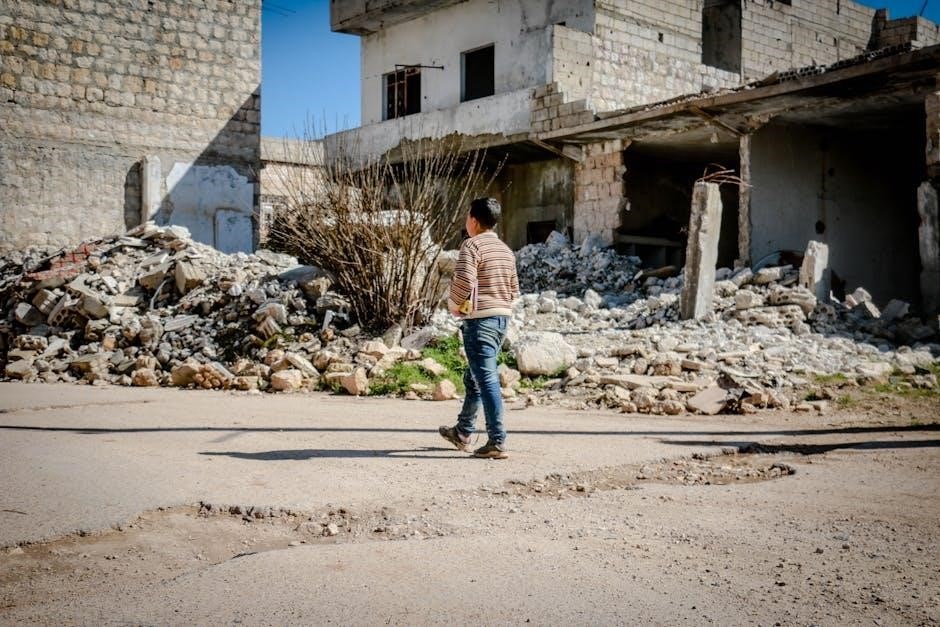Judith Herman’s Trauma and Recovery revolutionized understanding of psychological trauma‚ emphasizing its social and political contexts. This groundbreaking book provides a comprehensive exploration of trauma’s effects and treatment‚ blending survivor testimonies with therapeutic insights‚ becoming a foundational text in the field.
Overview of the Book’s Significance
Trauma and Recovery by Judith Herman‚ published in 1992‚ is a groundbreaking work that reshaped the understanding of psychological trauma. It shifted the focus from individual pathology to the societal and political contexts of traumatic experiences‚ emphasizing the role of power dynamics. The book introduced the concept of Complex Post-Traumatic Stress Disorder (C-PTSD) and outlined a three-stage recovery process: establishing safety‚ reconstructing the trauma story‚ and reconnecting with others. Herman’s work has become a foundational text in the field of trauma studies‚ influencing clinical practice‚ research‚ and advocacy. Its integration of survivor testimonies with therapeutic insights has made it invaluable for both professionals and survivors‚ fostering a deeper understanding of trauma’s impact and the path to healing.
Judith Herman’s Background and Expertise
Judith Lewis Herman‚ M.D.‚ is a renowned psychiatrist and trauma expert. She earned her medical degree from Harvard Medical School and has dedicated her career to understanding and treating psychological trauma. Herman’s work bridges psychiatry‚ sociology‚ and political science‚ offering a holistic perspective on trauma. She introduced the concept of Complex Post-Traumatic Stress Disorder (C-PTSD)‚ distinguishing it from traditional PTSD. Herman’s expertise is rooted in her extensive clinical experience and research with survivors of domestic abuse‚ sexual assault‚ and political violence. Her groundbreaking book‚ Trauma and Recovery‚ reflects her commitment to empowering survivors and addressing systemic injustices. Herman’s insights have profoundly influenced trauma treatment and advocacy‚ solidifying her status as a pioneer in the field.

The Concept of Trauma
Trauma involves experiences that shatter basic assumptions about safety and the world. It results from events overwhelming an individual’s capacity to cope‚ profoundly affecting survivors.
Defining Psychological Trauma
Psychological trauma‚ as defined by Judith Herman‚ occurs when individuals experience events that overwhelm their capacity to cope‚ shattering basic assumptions about safety and control. Such events disrupt the sense of self and the world‚ leading to profound emotional and psychological distress. Herman emphasizes that trauma can result from domestic abuse‚ political violence‚ or prolonged exploitation‚ highlighting the role of power dynamics in traumatic experiences. Her work distinguishes between single-event trauma and prolonged‚ repeated abuse‚ introducing the concept of Complex PTSD. This framework underscores the deep psychological and social dislocation caused by chronic trauma‚ including feelings of helplessness‚ disempowerment‚ and loss of connection to others and society.
The Social and Political Contexts of Trauma
Judith Herman highlights the profound role of social and political contexts in shaping traumatic experiences. She argues that trauma is deeply embedded in societal structures‚ such as power imbalances and systemic injustices‚ which often enable abuse and exploitation. Herman emphasizes that traumatic events‚ whether domestic violence or political terror‚ are not isolated incidents but reflections of broader cultural and institutional failures. The suppression of trauma narratives by those in power perpetuates suffering‚ as survivors are often silenced or discredited. Herman connects the recognition of trauma to historical movements‚ such as feminism and anti-colonial struggles‚ illustrating how societal change can validate survivors’ experiences and facilitate recovery. This perspective underscores the interplay between individual suffering and collective responsibility.
Understanding Traumatic Events and Their Impact
Traumatic events‚ as explored by Judith Herman‚ are experiences that overwhelm an individual’s capacity to cope‚ shattering fundamental assumptions about safety and the world. These events‚ whether acute or prolonged‚ leave deep psychological scars‚ disrupting a person’s sense of identity and trust. Herman emphasizes that trauma is not merely a personal experience but also a societal issue‚ often rooted in power imbalances and systemic injustices. The aftermath of trauma frequently manifests as emotional numbing‚ hypervigilance‚ and a fragmented narrative of the self. Herman’s work underscores the profound impact of trauma on both the individual and collective levels‚ highlighting the need for a holistic understanding that addresses the interplay of personal and societal factors in the healing process.

The Stages of Recovery
Judith Herman outlines three key stages of recovery: establishing safety‚ reconstructing the trauma story‚ and restoring connection with others. These phases guide survivors toward healing and reclaiming their lives.
Establishing Safety
Establishing safety is the first and most critical stage of recovery‚ as outlined in Judith Herman’s work. This phase focuses on creating a secure environment where survivors feel protected from further harm. Physical safety is prioritized‚ ensuring access to basic needs like shelter‚ food‚ and medical care. Emotional safety is equally vital‚ often achieved through therapy that fosters trust and control. Herman emphasizes the importance of empowering survivors to regain a sense of agency over their lives. Practical steps include establishing routines‚ self-care practices‚ and support networks. This foundation of safety allows survivors to process their trauma without feeling overwhelmed‚ setting the stage for further healing and reconstruction of their narratives.
Reconstructing the Trauma Story
Reconstructing the trauma story is a pivotal step in recovery‚ as described by Judith Herman. This process involves survivors recounting their traumatic experiences in a safe‚ structured manner. Through narrative exposure‚ individuals organize fragmented memories into a coherent account‚ reducing the overwhelming nature of the trauma. Herman emphasizes the importance of a supportive therapeutic relationship to facilitate this reconstruction. The goal is not to relive the trauma but to integrate it into the survivor’s life story‚ fostering understanding and mastery. This step helps reclaim the narrative‚ diminish shame‚ and restore a sense of control‚ enabling survivors to move beyond the trauma and rebuild their identities.
Restoring Connection with Community
Restoring connection with community is a vital stage in trauma recovery‚ as emphasized by Judith Herman. Traumatic experiences often lead to feelings of isolation and disconnection from others. Rebuilding social bonds helps survivors regain a sense of belonging and trust. Herman advocates for the importance of support groups and community involvement‚ where survivors can share their experiences and feel understood. This collective healing process fosters resilience and reduces stigma. By reconnecting with others‚ survivors can break the cycle of shame and alienation‚ reintegrating into society with renewed purpose. Community support plays a crucial role in empowering survivors to rebuild their lives and find meaning beyond their traumatic past.

Diagnostic Concepts Introduced by Herman
Judith Herman introduced Complex PTSD‚ expanding beyond traditional PTSD by addressing prolonged trauma effects‚ such as emotional dysregulation and significant losses‚ in her groundbreaking work.
Complex Post-Traumatic Stress Disorder (C-PTSD)
Judith Herman introduced the concept of Complex Post-Traumatic Stress Disorder (C-PTSD)‚ distinguishing it from traditional PTSD. C-PTSD arises from prolonged‚ repetitive trauma‚ such as chronic abuse or neglect‚ leading to profound emotional dysregulation‚ loss of identity‚ and distorted relationships. Unlike PTSD‚ which often follows a single traumatic event‚ C-PTSD reflects the cumulative impact of sustained trauma‚ affecting survivors’ ability to regulate emotions and maintain trust. Herman’s work emphasized the need to recognize C-PTSD as a distinct condition‚ addressing the complex psychological and social challenges faced by survivors of prolonged abuse. This concept has significantly influenced modern trauma diagnosis and treatment approaches‚ providing a framework for understanding the deeper‚ long-term effects of trauma.
Distinctions from Traditional PTSD
Judith Herman’s work highlights key distinctions between Complex PTSD (C-PTSD) and traditional PTSD. While traditional PTSD often stems from a single traumatic event‚ C-PTSD arises from prolonged‚ repetitive trauma‚ such as chronic abuse or neglect. Unlike PTSD‚ which may focus on specific symptoms like flashbacks‚ C-PTSD encompasses a broader range of psychological disturbances‚ including emotional dysregulation‚ identity fragmentation‚ and relational difficulties. Herman emphasizes that C-PTSD reflects the pervasive impact of sustained trauma on an individual’s sense of self and their ability to form trusting relationships. This distinction underscores the need for tailored therapeutic approaches that address the deeper‚ long-term effects of prolonged trauma‚ moving beyond the symptom-focused interventions typical in traditional PTSD treatment.

Treatment Approaches
Judith Herman’s Trauma and Recovery outlines treatment approaches emphasizing psychotherapy‚ narrative exposure‚ and community support. These methods help survivors process trauma‚ rebuild identity‚ and reconnect with others‚ fostering empowerment and healing.
Psychotherapy and Narrative Exposure
Judith Herman’s approach emphasizes the role of psychotherapy in trauma recovery‚ particularly through narrative exposure. This method involves helping survivors reconstruct their trauma story in a safe‚ structured manner. By integrating fragmented memories into a coherent narrative‚ individuals gain control over their experiences and reduce symptoms. Herman stresses the importance of establishing trust and safety in the therapeutic relationship‚ allowing survivors to process their trauma without feeling overwhelmed. Narrative exposure also facilitates emotional expression and meaning-making‚ enabling individuals to reclaim their identities and reconnect with others. This approach‚ blending psychotherapy with storytelling‚ empowers survivors to move beyond the trauma‚ fostering resilience and healing. Herman’s techniques remain foundational in modern trauma treatment.
The Role of Medication in Trauma Recovery
Medication plays a supplementary role in trauma recovery‚ primarily addressing symptoms like anxiety‚ depression‚ or hyperarousal. While not a central focus of Herman’s work‚ it can alleviate acute distress‚ enabling engagement in psychotherapy. SSRIs or mood stabilizers are commonly prescribed to manage these symptoms. However‚ Herman emphasizes that medication alone cannot resolve trauma; it must be part of a broader therapeutic plan. The book underscores the importance of combining medication with psychotherapy and social support for holistic healing. Herman’s approach advocates for understanding trauma within its social context‚ ensuring that recovery addresses both individual and societal factors. This balanced perspective highlights the necessity of integrating medical and psychological interventions to foster resilience and recovery. Medication‚ thus‚ serves as a tool to support‚ rather than replace‚ the therapeutic process.
Support Groups and Community Involvement
Support groups and community involvement are integral to trauma recovery‚ fostering a sense of safety and connection. Herman highlights the importance of collective healing‚ where survivors share experiences‚ reducing isolation. These groups validate feelings and empower individuals‚ helping them rebuild trust. Community involvement further encourages societal acknowledgment of trauma‚ promoting advocacy and systemic change. Herman emphasizes that healing is not solitary but deeply rooted in social support and collective action. By engaging with others‚ survivors regain a sense of control and purpose‚ which is vital for long-term recovery. This approach underscores the transformative power of community in addressing trauma’s pervasive effects.

The Role of Society in Trauma and Recovery
Society plays a crucial role in trauma and recovery by influencing recognition‚ denial‚ and support systems. Herman highlights the cyclic pattern of societal acknowledgment and suppression of traumatic experiences‚ which significantly impacts survivors’ ability to heal and seek justice.
Historical Perspectives on Trauma Recognition
Judith Herman’s work highlights the fluctuating recognition of trauma throughout history‚ often tied to societal and political movements. During times of war or social upheaval‚ such as World War I and the women’s movement‚ trauma gained visibility‚ only to be dismissed in periods of stability. Herman traces how the medical community alternately acknowledged and minimized trauma‚ reflecting broader cultural attitudes. The cyclic pattern of recognition and denial has profound implications for survivors‚ as societal validation is crucial for healing. Herman’s analysis underscores the interplay between historical context and the understanding of trauma‚ revealing how political and social forces shape both the identification and treatment of traumatic experiences across generations.
Societal Denial and Its Effects on Survivors
Judith Herman’s work examines how societal denial of trauma perpetuates suffering for survivors. By dismissing or minimizing traumatic experiences‚ society invalidates survivors’ realities‚ leading to isolation and shame. This denial often stems from a collective fear of confronting the darker aspects of human behavior and the structures that enable violence. Herman argues that such denial is not merely an oversight but an active process that reinforces power imbalances and silences marginalized voices.
The effects of societal denial are profound‚ as survivors often internalize this invalidation‚ further complicating their recovery. Herman emphasizes that true healing requires not only individual therapy but also societal acknowledgment and accountability‚ highlighting the interconnectedness of personal trauma and broader cultural attitudes.
Advocacy and Policy Changes for Trauma Survivors
Judith Herman’s work underscores the critical role of advocacy and policy changes in supporting trauma survivors. She argues that societal recognition of trauma must translate into concrete actions‚ such as legal reforms and improved access to mental health services. Herman emphasizes the importance of creating safe environments where survivors feel empowered to share their experiences without fear of retaliation or judgment. Advocacy efforts have led to significant policy reforms‚ including better protections for victims of domestic violence and sexual assault. Additionally‚ Herman highlights the need for systemic changes that address the root causes of trauma‚ such as inequality and discrimination‚ to prevent future atrocities and foster a more compassionate society.

Case Studies and Survivors’ Testimonies
Trauma and Recovery features compelling case studies and survivor testimonies‚ offering profound insights into the psychological and emotional impacts of trauma. Herman’s use of pseudonyms protects identities while amplifying voices‚ validating survivors’ experiences and illustrating the path to healing.
The Use of Pseudonyms in Case Studies
In Trauma and Recovery‚ Judith Herman employs pseudonyms to protect the identities of trauma survivors‚ ensuring confidentiality while sharing their stories. This ethical approach allows survivors to speak openly about their experiences without fear of stigma or repercussions. The use of pseudonyms is a crucial aspect of Herman’s methodology‚ as it fosters trust and authenticity in the therapeutic process. While most individuals are anonymized‚ there are rare exceptions where survivors consent to the use of their real names. This practice not only respects privacy but also underscores the importance of amplifying survivors’ voices. By balancing confidentiality with narrative authenticity‚ Herman’s work gains credibility and depth‚ making it a powerful tool for understanding trauma and recovery.
Key Insights from Survivor Narratives
Judith Herman’s Trauma and Recovery highlights the profound insights gained from survivor narratives‚ which form the core of her analysis. These stories reveal the devastating impact of trauma on individuals’ lives‚ often shattering their sense of safety and identity. Survivors’ testimonies expose the pervasive effects of prolonged abuse and violence‚ emphasizing the destruction of trust and the fragmentation of self. Herman underscores the resilience and adaptability of survivors‚ who develop unique coping strategies to navigate their traumatic experiences. By centering these narratives‚ Herman humanizes trauma survivors and underscores the importance of empathy and understanding in the healing process. These accounts not only illuminate the complexities of trauma but also advocate for societal recognition and change.

Criticism and Reception of the Book

Trauma and Recovery received widespread acclaim for its groundbreaking insights but faced critiques for its dense academic style. Admirers praised its introduction of C-PTSD‚ while others found it less accessible.
Academic and Clinical Reception
Judith Herman’s Trauma and Recovery was met with significant academic and clinical acclaim upon its release. The book was praised for its innovative approach to understanding psychological trauma‚ particularly its emphasis on the social and political contexts that shape traumatic experiences. Clinicians and researchers widely adopted Herman’s concept of Complex Post-Traumatic Stress Disorder (C-PTSD)‚ which filled a critical gap in the understanding of prolonged trauma. The text became a foundational resource in the field of trauma studies‚ influencing both research and clinical practice. Its integration of survivor testimonies added depth and authenticity‚ making it a seminal work for mental health professionals seeking to address trauma effectively. The book’s insights continue to guide modern approaches to trauma treatment and recovery.
Public and Survivor Feedback
Public and survivor feedback on Trauma and Recovery has been overwhelmingly positive‚ with many crediting the book for validating their experiences. Survivors appreciate Herman’s compassionate and insightful approach‚ which acknowledges the complexity of trauma and offers hope for healing. The book’s accessibility and comprehensive analysis have made it a vital resource for both survivors and the general public. Many have praised its ability to articulate the emotional and psychological aftermath of traumatic events‚ providing a framework for understanding and recovery. Herman’s use of survivor testimonies adds a powerful‚ human dimension‚ resonating deeply with readers who feel seen and heard through her work. This connection has solidified the book’s impact as a transformative and empowering text.
Critiques and Controversies Surrounding the Book
While Trauma and Recovery has been widely praised‚ it has also faced some critiques and controversies. Some scholars argue that Herman’s broadening of the trauma concept to include societal and political factors risks diluting its clinical specificity. Others have debated the diagnostic validity of Complex PTSD‚ questioning its distinction from other disorders like borderline personality disorder. Additionally‚ certain critics feel that Herman’s focus on survivor narratives‚ while powerful‚ may occasionally overshadow empirical research. Despite these debates‚ the book remains a foundational text‚ with its critiques largely reflecting the evolving nature of trauma studies rather than undermining its significance. Herman’s work continues to spark important discussions in the field.

Impact on Modern Trauma Treatment
Trauma and Recovery profoundly influenced modern trauma treatment by integrating psychological and social perspectives‚ reshaping clinical approaches and inspiring new research and training programs for mental health professionals.
Integration into Clinical Practice Guidelines
Judith Herman’s work has significantly influenced clinical practice guidelines by introducing a trauma-informed care approach. Her concept of Complex PTSD and the three stages of recovery—establishing safety‚ reconstructing the trauma story‚ and reconnecting with others—have been widely adopted. Professional organizations and mental health institutions now incorporate these principles into treatment protocols‚ emphasizing patient-centered and empathetic care; Herman’s emphasis on the social and political contexts of trauma has also led to more holistic approaches in therapy. Her work is now part of evidence-based practices‚ shaping how clinicians diagnose and treat trauma. This integration has improved outcomes for survivors‚ ensuring a more compassionate and effective healing process.
Influence on Trauma Research and Studies
Judith Herman’s Trauma and Recovery has profoundly shaped trauma research by introducing the concept of Complex PTSD and emphasizing the importance of understanding trauma within social and political contexts. Her work has inspired studies on prolonged and repeated trauma‚ particularly in contexts like domestic abuse and political violence. By challenging the traditional medical model‚ Herman’s research has encouraged a broader‚ interdisciplinary approach to understanding trauma. Her emphasis on survivor testimonies has also influenced methodologies in trauma studies‚ prioritizing the voices of those affected. This shift has led to more comprehensive research on the long-term effects of trauma and the development of innovative therapeutic approaches‚ solidifying her work as a cornerstone in the field.
Training and Education for Mental Health Professionals
Judith Herman’s work has significantly influenced the training and education of mental health professionals by providing a foundational understanding of trauma and recovery. Her book emphasizes the importance of recognizing the social and political contexts of trauma‚ which has informed the development of trauma-informed care training programs. Herman’s framework‚ which includes stages of recovery such as establishing safety and reconstructing the trauma story‚ has been integrated into therapeutic education. This has equipped professionals with practical tools to address complex trauma. Additionally‚ her advocacy for survivor-centered care has reshaped how clinicians approach treatment‚ fostering empathy and understanding. As a result‚ her work continues to be a cornerstone in the education of mental health practitioners worldwide.
Judith Herman’s work has profoundly influenced the field of trauma‚ shaping modern understanding and treatment approaches‚ leaving a lasting legacy in psychology and paving the way for future research and healing.
Legacy of Judith Herman’s Work
Judith Herman’s Trauma and Recovery has left an indelible mark on the field of psychology and trauma studies. Her groundbreaking work introduced the concept of Complex PTSD and emphasized the importance of societal and political contexts in understanding trauma. By prioritizing survivors’ voices and advocating for systemic change‚ Herman’s book has become a cornerstone for modern trauma treatment and research. Her insights have influenced clinical practices‚ research methodologies‚ and policy reforms‚ ensuring that trauma survivors receive compassionate and informed care. Herman’s legacy continues to inspire professionals and empower survivors‚ solidifying her role as a pioneer in the field of psychological trauma and recovery.
Future Directions in Trauma and Recovery Research
Future research in trauma and recovery is expected to expand on Herman’s foundational work by exploring emerging trends and innovative approaches. A key focus will be on understanding the interplay between neurobiology and psychological trauma‚ particularly in the context of Complex PTSD. Advances in technology‚ such as teletherapy and AI-driven tools‚ may enhance accessibility to trauma care. Additionally‚ there is a growing emphasis on addressing collective trauma caused by societal crises like climate change and systemic inequality. Cultural sensitivity and inclusivity in trauma treatment will also be prioritized to ensure equitable care for diverse populations. By integrating these directions‚ the field aims to create more holistic and effective strategies for trauma recovery‚ building on Herman’s legacy of compassionate and socially conscious research.

